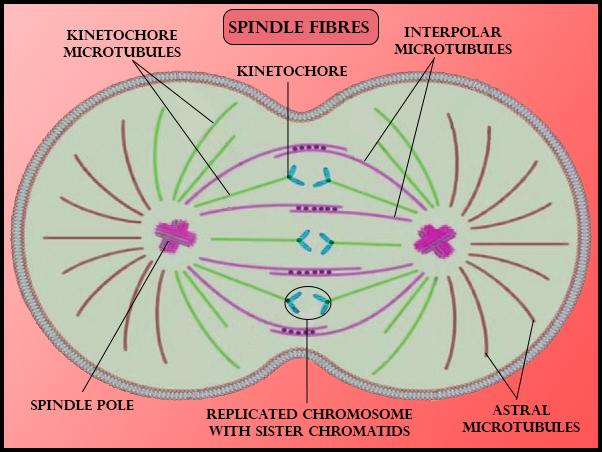
The spindle fibers which extend from pole to kinetochore are
(a)Chromosomal or tractile
(b)Interzonal fibers
(c)Continuous fibers
(d)Astral rays
Answer
580.8k+ views
Hint: It helps in the alignment of chromosomes at the equatorial plate and in the separation of sister chromatids during cell division.
Complete answer:
The spindle fibers which extend from pole to the kinetochore are also known as Chromosomal or tractile fibers.
-The spindle apparatus is an important characteristic of eukaryotic cells. It consists of the cytoskeleton structure i.e. spindle fibers that helps in the splitting of sister chromatids during cell division.
-The spindle fiber is a type of microtubule raised from the centrioles present inside the centrosome at poles.
-The spindle fiber gets attached to the kinetochore during the metaphase of mitosis or meiosis. In metaphase, it helps in the alignment of the chromosomes at the equator or metaphase plate.
-It consists of proteins like kinesin, dynein, and tubulin.
Additional information:
The microtubules present in a cell can be categorized into three types:
-Kinetochore microtubules- These microtubules attach to the kinetochore.
-Interpolar microtubules- These are also known as continuous fibers. These microtubules join the two poles at opposite sides of the dividing cell.
-Astral microtubules- These microtubules extend into the cortical cytoplasm and help the centrosome to lie firmly in its position. They neither attach to the kinetochore nor to the other microtubules.
So, the correct answer is ‘Astral rays'.
Note:
-The spindle fiber taking part in mitosis is known as mitotic spindle whereas the fibers taking part in meiosis is known as meiotic spindle.
-Kinesin and dynein protein with the help of ATP move towards the opposite ends of the microtubules i.e. plus and minus ends respectively. This ‘walking’ movement of these proteins is helpful in the transportation of organelles and other structures.
-The inter zonular fibers are formed between the centromeres of the separating sister chromatids at the time of cell division.

Complete answer:
The spindle fibers which extend from pole to the kinetochore are also known as Chromosomal or tractile fibers.
-The spindle apparatus is an important characteristic of eukaryotic cells. It consists of the cytoskeleton structure i.e. spindle fibers that helps in the splitting of sister chromatids during cell division.
-The spindle fiber is a type of microtubule raised from the centrioles present inside the centrosome at poles.
-The spindle fiber gets attached to the kinetochore during the metaphase of mitosis or meiosis. In metaphase, it helps in the alignment of the chromosomes at the equator or metaphase plate.
-It consists of proteins like kinesin, dynein, and tubulin.
Additional information:
The microtubules present in a cell can be categorized into three types:
-Kinetochore microtubules- These microtubules attach to the kinetochore.
-Interpolar microtubules- These are also known as continuous fibers. These microtubules join the two poles at opposite sides of the dividing cell.
-Astral microtubules- These microtubules extend into the cortical cytoplasm and help the centrosome to lie firmly in its position. They neither attach to the kinetochore nor to the other microtubules.
So, the correct answer is ‘Astral rays'.
Note:
-The spindle fiber taking part in mitosis is known as mitotic spindle whereas the fibers taking part in meiosis is known as meiotic spindle.
-Kinesin and dynein protein with the help of ATP move towards the opposite ends of the microtubules i.e. plus and minus ends respectively. This ‘walking’ movement of these proteins is helpful in the transportation of organelles and other structures.
-The inter zonular fibers are formed between the centromeres of the separating sister chromatids at the time of cell division.

Recently Updated Pages
Master Class 12 English: Engaging Questions & Answers for Success

Master Class 12 Economics: Engaging Questions & Answers for Success

Master Class 12 Social Science: Engaging Questions & Answers for Success

Master Class 12 Maths: Engaging Questions & Answers for Success

Master Class 12 Chemistry: Engaging Questions & Answers for Success

Master Class 12 Business Studies: Engaging Questions & Answers for Success

Trending doubts
What are the major means of transport Explain each class 12 social science CBSE

Which are the Top 10 Largest Countries of the World?

Draw a labelled sketch of the human eye class 12 physics CBSE

Explain sex determination in humans with line diag class 12 biology CBSE

The pH of the pancreatic juice is A 64 B 86 C 120 D class 12 biology CBSE

Explain sex determination in humans with the help of class 12 biology CBSE




